
A | B | C | D | E | F | G | H | CH | I | J | K | L | M | N | O | P | Q | R | S | T | U | V | W | X | Y | Z | 0 | 1 | 2 | 3 | 4 | 5 | 6 | 7 | 8 | 9
| Russian Armed Forces |
|---|
 |
| Staff |
| Services (vid) |
| Independent troops (rod) |
| Special operations force (sof) |
| Other troops |
| Military districts |
| History of the Russian military |
The Armed Forces of the Russian Federation,[a] commonly referred to as the Russian Armed Forces, are the military of Russia. It is organized into three service branches—the Ground Forces, Navy, and Aerospace Forces—two independent combat arms (the Strategic Rocket Forces and Airborne Forces),[10] and the Special Operations Forces Command.[11]
The Russian Armed Forces are the world's fifth largest military force, with 1.15 million active-duty personnel and close to two million reservists.[12] According to the United States Central Intelligence Agency (CIA), "Russia plans to expand its active personnel force to 1.5 million by 2026, which will make it the third largest in the world, after China and India."[13] The Russian Armed Forces maintain the world's largest stockpile of nuclear weapons.[14] possess the world's second-largest fleet of ballistic missile submarines,[15] and are one of only three national militaries (alongside those of the United States and China) that operate strategic bombers.[16] With certain exceptions, Russian law mandates one year of military service for all male citizens aged 18–27.[1][17] In 2023, Russia had the world's third-highest military expenditure, at approximately US$86.4 billion to US$109 billion, or close to six percent of GDP.[18][5]
In spite of Russia's perceived military strength, as recorded in various assessments, deficiencies have been noted in the country's combat performance on both the tactical and operational scales. According to multiple reports, endemic corruption within the Russian Armed Forces has had a major impact on Russia's ability to effectively project hard power.[19][20][21] Amidst the Russian invasion of Ukraine, severe logistical failures have greatly impacted the operational performance of Russian troops, as different service branches have struggled to coordinate and work together. Continuous shortcomings have led Russia's war effort to suffer extensive setbacks since the initial invasion; the Russian Armed Forces have experienced successive losses of occupied/annexed territory, the large-scale destruction and squandering of their equipment, and a notably high casualty rate.[22][23][24] Researchers from the U.S.-funded RAND Corporation have observed that Russia continues to struggle with military professionalization.[25]
Directly controlled by the Security Council of Russia, the Russian Armed Forces form part of the country's defence services under Russian law, fulfilling this capacity alongside the Border Guard of the Federal Security Service, the National Guard, the Ministry of Internal Affairs, the Federal Protective Service, the Foreign Intelligence Service, and the Ministry of Emergency Situations.
Service branches
Armed forces under the Ministry of Defence are divided into:[citation needed]
- The three branches of Armed Forces: the Ground Forces, Aerospace Forces, and Navy
- The two separate troop branches: the Strategic Rocket Forces and Airborne Forces
- The special forces of Armed Forces: the Special Operations Forces
- The Logistical Support of the Russian Armed Forces, which has a separate status of its own
There are additionally two further separate troop branches, the National Guard and the Border Service. These retain the legal status of "Armed Forces", while falling outside of the jurisdiction of the General Staff of the Armed Forces of the Russian Federation. The National Guard is formed on the basis of the former Internal Troops of Russia. The new structure has been detached from the Ministry of Internal Affairs into a separate agency, directly subordinated to the President of Russia. The Border Service is a paramilitary organization of the Federal Security Service, the country's main internal intelligence agency. Both organizations have significant wartime tasks in addition to their main peacetime activities and operate their own land, air and maritime units.
The number of personnel is specified by decree of the President of Russia. On 1 January 2008, a number of 2,019,629 units, including military of 1,134,800 units, was set.[26] In 2010 the International Institute for Strategic Studies (IISS) estimated that the Russian Armed Forces numbered about 1,027,000 active troops and in the region of 2,035,000 reserves (largely ex-conscripts).[27] As opposed to personnel specified by decree, actual personnel numbers on the payroll was reported by the Audit Chamber of Russia as 766,000 in October 2013.[28]
According to the Stockholm International Peace Research Institute, between 2005–2009 and 2010–2014, Russian exports of major weapons increased by 37 percent;[29] Russia spent $66.4 billion on arms in 2015,[30] then $69.2 billion in 2016, having taken 3rd place (after the U.S. and China).[31]
History
The Soviet Union officially dissolved on 25 December 1991. For the next year various attempts to keep its unity and to transform it into the military of the Commonwealth of Independent States (CIS) failed. Over time, some units stationed in the newly independent republics swore loyalty to their new national governments, while a series of treaties between the newly independent states divided up the military's assets.[32]
Apart from assuming control of the bulk of the former Soviet Internal Troops and the KGB Border Troops, seemingly the only independent defence move the new Russian government made before March 1992 involved announcing the establishment of a National Guard.[33] Until 1995, it was planned to form at least 11 brigades numbering 3,000 to 5,000 each, with a total of no more than 100,000. National Guard military units were to be deployed in 10 regions, including in Moscow (three brigades), (two brigades), and a number of other important cities and regions. In Moscow alone 15,000 personnel expressed their desire to service in the new Russian Army, mostly former Soviet Armed Forces servicemen. In the end, President Yeltsin tabled a decree "On the temporary position of the Russian Guard", but it was not put into practice.[34]
After signing the Belavezha Accords on 21 December 1991, the countries of the newly formed CIS signed a protocol on the temporary appointment of Marshal of Aviation Yevgeny Shaposhnikov as Minister of Defence and commander of the armed forces in their territory, including strategic nuclear forces. On 14 February 1992 Shaposhnikov formally became Supreme Commander of the CIS Armed Forces. On 16 March 1992 a decree by Boris Yeltsin created the Armed Forces of the Russian Federation, the operational control of Allied High Command and the Ministry of Defence, which was headed by President.[citation needed] Finally, on 7 May 1992, Yeltsin signed a decree establishing the armed forces and Yeltsin assumed the duties of the Supreme Commander.[35]
In May 1992, General Colonel Pavel Grachev became the Minister of Defence, and was made Russia's first Army General on assuming the post. By August or December 1993 CIS military structures had become CIS military cooperation structures with all real influence lost.[36]
In the next few years, Russian forces withdrew from central and eastern Europe, as well as from some newly independent post-Soviet republics. While in most places the withdrawal took place without any problems, the Russian Armed Forces remained in some disputed areas such as the Sevastopol naval base in the Crimea as well as in Abkhazia, South Ossetia and in Transnistria. The Armed Forces have several bases in foreign countries, especially on territory of the former Soviet Republics.
In late 2000 Gazeta.ru reported that of 600,000 personnel planned to be dismissed from the various "power ministries," the Armed Forces would be reduced by 365,000.[37]
Both in Soviet and Russian times, corruption has been a significant impediment to the Armed Forces. "The change from Yeltsin to Putin ..had minimal effect on Russian military corruption. Putin, despite his desire to rebuild Russian strength, has not shown himself willing or able to seriously deal with" corruption.[38] From 1991 to 2001, Russian authorities uncovered at least 350 billion rubles' (US$11.5 billion) worth of corruption in the armed forces (with, for comparison, the total defence budget for 2001 being 214 billion rubles). Areas of particular concern identified by a researcher at the Norwegian Defence Research Establishment in 2007 included the State Defence Order (perhaps 10-15% realised in 2004); "ghost soldiers," as "it is generally acknowledged that the number of actually serving personnel differs substantially from the authorized number of personnel," and officers at various levels can pocket excess money for themselves; and "the domestic purchases of goods and services, where corrupt officers overpay civilian providers in return for bribes."
On 24 February 2022 Russian president Vladimir Putin gave the execute order to for the Armed Forces to begin the Russian invasion of Ukraine.[40][41] On 10 April 2022 General Aleksandr Dvornikov assumed command of the operation.[42] In July 2022, at the same time as the Armed Forces began suffering severe casualties, the Ground Forces began to site ammunition in or near structures which are frequented by civilians due to the human shield benefit, ostensibly because Ukrainian HIMARS had tilted the odds of his strategy of attrition by artillery.[43] Within hours after Defence Minister Sergei Shoigu's signature on the UN-brokered deal to resume Ukraine's Black Sea grain exports, Russia bombed the Port of Odesa.[44][45]
According to Forbes Moscow had committed, as of the end of July 2022, 10 of its Combined Arms Armies to the invasion.[46] The Wagner Group has made a name for itself as Putin's "private army."[47] In June 2023, Putin backed the Ministry of Defense's plan to make mercenary groups sign contracts, which Wagner leader Yevgeny Prigozhin pushed against: these contracts would have placed the Wagner Group under the Ministry's command structure as subordinates and limited Prigozhin's own influence.[48] Later in June, the Wagner Group turned against the Russian invasion of Ukraine and the Ministry of Defense[49][50] until a peace deal was reached. According to Prigozhin, part of the reason for his march against Russia was to stop the government from " PMC Wagner."[51]
Structure


The Defence Ministry of the Russian Federation serves as the administrative body of the Armed Forces. Since Soviet times, the General Staff has acted as the main commanding and supervising body of the Russian armed forces. "he Soviet General Staff without the MoD is conceivable, but the MoD without the General Staff is not."[52]
Other departments include the Main Intelligence Directorate, the personnel directorate as well as the Logistical Support of the Russian Armed Forces, Railway Troops, Signal Troops and Construction Troops. The Ministry of Defence incorporated the Main Directorate of the Military Police Since 1 December 2012. The Main Directorate of the Military Police oversees subordinated military districts regional directorates of military police.[53] The Chief of the General Staff is currently General of the Army Valery Gerasimov.
In July 2018, the Main Military-Political Directorate of the Russian Armed Forces was created, restoring a responsibility for ideological training that had been done away with in the Soviet Armed Forces.[54]
The Russian military is divided into three services: the Russian Ground Forces, the Russian Navy, and the Russian Aerospace Forces. In addition there are two independent arms of service: the Strategic Missile Troops and the Russian Airborne Troops. The Armed Forces as a whole are traditionally referred to as the Army (armiya), except in some cases, the Navy is specifically singled out.
Military districts
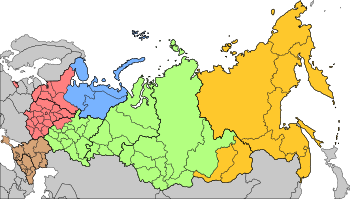
Since late 2010, the Ground Forces as well as the Aerospace Forces and Navy are distributed among four military districts: Western Military District, Southern Military District, Central Military District, and the Eastern Military District which also constitute four Joint Strategic Commands—West, South, Central, and East. Previously from 1992 to 2010, the Ground Forces were divided into six military districts: Moscow, Leningrad, North Caucausian, Privolzhsk-Ural, Siberian and Far Eastern, with the seventh military district: Kaliningrad formed in 1997; in service until 2010.
Russia's four naval fleets and one flotilla were organizations on par with the Ground Forces' Military Districts. These seven MDs were merged into the four new MDs, which now also incorporate the aerospace forces and naval forces. There is one remaining Russian military base, the 102nd Military Base, in Armenia left of the former Transcaucasus Group of Forces and is incorporated into the Southern Military District.
In mid-2010 a reorganisation was announced which consolidated military districts and the navy's fleets into four Joint Strategic Commands (OSC).[55] In 2014 the Northern Fleet was reorganized in separate Joint Strategic Command. Since 1 January 2021, this Command has the status of military district.[56]

Geographically divided, the five commands/districts are:
- Joint Strategic Command West – Western Military District (HQ in St. Petersburg), includes the Baltic Fleet;
- Joint Strategic Command North – Northern Military District (HQ in Severomorsk), includes the Northern Fleet;
- Joint Strategic Command South – Southern Military District (HQ in Rostov-on-Don) includes the Black Sea Fleet and Caspian Flotilla;
- Joint Strategic Command Center – Central Military District (HQ in Yekaterinburg);
- Joint Strategic Command East – Eastern Military District (HQ in Khabarovsk), includes the Pacific Fleet.
The plan was put in place on 1 December 2010 and mirrors a proposed reorganisation by former Chief of the General Staff Army General Yuri Baluyevsky for a Regional Command East which was not implemented.[57] The four commands were set up by a decree of President Medvedev on 14 July 2010.[citation needed] In July 2011, an Operational-Strategic Command of Missile-Space Defence has also been established on the basis of the former Special Purpose Command of the Russian Air Force. A Presidential decree of January 2011 named commanders for several of the new organisational structures.[58]
Russian security bodies not under the control of the Ministry of Defence include the Internal Troops of the Ministry of Internal Affairs (now the National Guard of Russia's National Guard Forces Command), the Border Guard Service of Russia (part of the Federal Security Service), the Kremlin Regiment and the rest of the Federal Protective Service, and the Ministry of Emergency Situations, the country's civil defence service since 1995 and successor to earlier civil defence units.
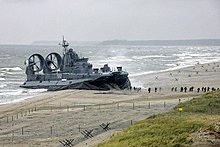

The Navy consists of four fleets and one flotilla:
- Northern Fleet (HQ at Severomorsk) forms own Joint Strategic Command.
- Baltic Fleet (HQ at Kaliningrad in the exclave of Kaliningrad Oblast) subordinated to Joint Strategic Command West.
- Black Sea Fleet (HQ at Sevastopol, disputed region of Crimea) subordinated to Joint Strategic Command South.
- Pacific Fleet (HQ at Vladivostok) subordinated to Joint Strategic Command East.
- Caspian Flotilla (HQ at Astrakhan) subordinated to Joint Strategic Command South.
Personnel

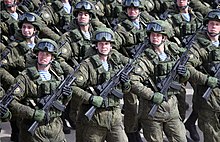
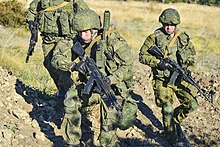

This section may contain an excessive amount of intricate detail that may interest only a particular audience. Specifically, Tables of age limits could be summarized. (August 2022) |
Conscription is used in Russia; the term of service is 12 months; and the eligible age is between 18 and 27 years old.[1] Deferments are provided to undergraduate and graduate students, men supporting disabled relatives, parents of at least two children and—upon Presidential proclamation—to some employees of military-oriented enterprises. Men holding a Ph.D., as well as sons and brothers of servicemen killed or disabled during their military service, are released from conscription.
There were widespread problems with hazing in the Army, known as dedovshchina, where first-year draftees are abused by second-year draftees, a practice that appeared in its current form after the change to a two-year service term in 1967.[59] According to Anna Politkovskaya, in 2002, "a complete battalion, more than five hundred men, had been killed not by enemy fire but by beatings".[60] Over a period of 9 months in 2003, 2,500 personnel were accused of dedovshchina, of which half were sentenced.[61] To combat this problem, a new decree was signed in March 2007, which cut the conscription service term from 24 to 18 months. The term was cut further to one year on 1 January 2008.[62][63]
Thirty percent of Russian Armed Forces' personnel were contract servicemen at the end of 2005.[17] For the foreseeable future, the Armed Forces will be a mixed contract/conscript force.[17] The Russian Armed Forces need to maintain a mobilization reserve to have manning resources capable of reinforcing the permanent readiness forces if the permanent readiness forces cannot deter or suppress an armed conflict on their own.[64]
Recruitment into the Russian military are also open to non-Russian citizens of the Commonwealth of Independent States, of which Russia is the largest member.[65] By December 2003, the Russian parliament had approved a law in principle to permit the Armed Forces to employ foreign nationals on contract by offering them Russian citizenship after several years service[66] yet, up to 2010, foreigners could only serve in Russia's armed forces after getting a Russian passport. Under a 2010 Defence Ministry plan, foreigners without dual citizenship would be able to sign up for five-year contracts and will be eligible for Russian citizenship after serving three years.[67][68] The change could open the way for CIS citizens to get fast-track Russian citizenship, and counter the effects of Russia's demographic crisis on its army recruitment. Each soldier in duty receives an Identity Card of the Russian Armed Forces. On 20 September 2022 the State Duma passed a bill which would make Russian citizenship available to foreign soldiers upon 12 months service in the AFRF; previously the service requirement had been set at three years.[69]
Awards and decorations of the Armed Forces are covered at the Awards and Emblems of the Ministry of Defence of the Russian Federation.
On 17 November 2011, General Nikolai Makarov said that Russia had reached a crisis in the conscript service where there simply were not sufficient able bodied men to draft and was forced to halve its conscription.[citation needed]
In March 2013, Defence Minister Sergey Shoygu promised that all army quarters would have showers by the end of the year.[70]
In 2013, it was reported that:[71] "Compared to 2007, the number of female officers and warrant-officers has dropped by nearly two thirds. There were over 30,000 women serving under a contract in 2007, and now there are only slightly more than 11,000 of them, including 4,300 officers of various rank." Lt. Col. Yelena Stepanova, the chief of the social processes monitoring department at the Russian armed forces' sociological research center, said. This trend "not ..special" but correspond with the general .. reduction of the Russian armed forces."
A new uniform for hot climates was introduced in mid-2018.[72]
On 28 May 2022, on the background of the ongoing invasion of Ukraine, Vladimir Putin signed the law which removed the upper age limit for signing first contract for the performance of voluntary military service (earlier this limit was 40 years old).[73][74]
| Military rank | Conscript service | Voluntary service | ||||
|---|---|---|---|---|---|---|
| Lower age limit | Upper age limit | Lower age limit for signing first contract | Upper age limit for signing first contract | General upper age limit for tenure | Final upper age limit for tenure | |
| Marshal of the Russian Federation | None | None | 18 | None | 65 | 70 |
| Army general/Admiral of the fleet | ||||||
| Colonel general/Admiral | ||||||
| Lieutenant general/Vice admiral | 60 | 65 | ||||
| Major general/Counter admiral | ||||||
| Colonel/Captain 1st rank | 55 | |||||
| Lieutenant colonel/Captain 2nd rank | 50 | |||||
| Major/Captain 3rd rank | ||||||
| Captain/Captain lieutenant | ||||||
| Senior lieutenant | ||||||
| Lieutenant | ||||||
| Junior lieutenant | ||||||
| Senior praporshchik/Senior michman | ||||||
| Praporshchik/Michman | ||||||
| Starshina/Chief ship starshina | ||||||
| Senior sergeant/Chief starshina | ||||||
| Sergeant/Starshina 1st class | ||||||
| Junior sergeant/Starshina 2nd class | ||||||
| Gefreiter/Senior seaman | ||||||
| Private/Seaman | 18 | 27 | ||||
| Military rank | Conscript service | Voluntary service | ||||
|---|---|---|---|---|---|---|
| Lower age limit | Upper age limit | Lower age limit for signing first contract | Upper age limit for signing first contract | General upper age limit for tenure | Final upper age limit for tenure | |
| Marshal of the Russian Federation | None | None | 18 | None | 45 | 70 |
| Army general/Admiral of the fleet | ||||||
| Colonel general/Admiral | ||||||
| Lieutenant general/Vice admiral | 65 | |||||
| Major general/Counter admiral | ||||||
| Colonel/Captain 1st rank | ||||||
| Lieutenant colonel/Captain 2nd rank | ||||||
| Major/Captain 3rd rank | ||||||
| Captain/Captain lieutenant | ||||||
| Senior lieutenant | ||||||
| Lieutenant | ||||||
| Junior lieutenant | ||||||
| Senior praporshchik/Senior michman | ||||||
| Praporshchik/Michman | ||||||
| Starshina/Chief ship starshina | ||||||
| Senior sergeant/Chief starshina | ||||||
| Sergeant/Starshina 1st class | ||||||
| Junior sergeant/Starshina 2nd class | ||||||
| Gefreiter/Senior seaman | ||||||
| Private/Seaman | ||||||
Military education
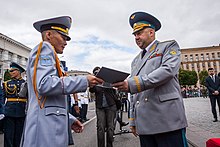
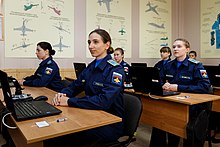
The Russian military education system, inherited from the Soviet Union, trains officer-specialists in narrowly-defined military occupational specialties. In this it differs greatly from the American military education system in which newly qualified second lieutenants receive particular specialties in the framework of their "career branch" only after graduation from a military academy or the ROTC.[75] Students of Russian civilian institutions of higher education wishing to join the reserve officer training program cannot choose a military occupational specialty, because each civilian specialty taught by civilian university is attached to a particular military occupational specialty taught by the military training center of the same university by the rector's order. It also differs from the American military education system in which students can choose between available types of ROTC.
The Russian military education system includes:
- Warrant officer schools, which prepare career warrant officers for active duty service.
- Higher military schools, which prepare career commissioned officers for active duty service as platoon/company commanders and at equivalent positions (tactical level).
- Military training centers within civilian institutions of higher education, which prepare reserve commissioned officers who can serve as platoon/company commanders and at equivalent positions (tactical level).
- Military academies, which improve the military occupational specialty knowledge of commissioned officers to allow them to be appointed to battalion/regiment/brigade commander or equivalent positions (operational-tactical level).
- Military Academy of the General Staff of the Armed Forces of Russia, which improves skills of officers graduated from military academies to allow them to become highest-ranking military officers (strategic level).
- Adjunctura is a military analogue of civilian graduate school, which allow commissioned officers to get academic degree of candidate of sciences in military oriented specialties and be appointed to a teaching positions in military academies, military schools, military training centers.
| Type of military educational institution | Persons who have not been on active duty service | Persons who are on conscript active duty service or are demobbed from this service | Persons who are on voluntary active duty service | |||
|---|---|---|---|---|---|---|
| Lower age limit | Upper age limit | Lower age limit | Upper age limit | Lower age limit | Upper age limit | |
| Military school | 16 | 22 | 18 | 24 | 18 | 27 |
| Military training center (active duty officer program) | 16 | 24 | — | — | — | — |
| Military training center (reserve officer program) | 16 | 30 | — | — | — | — |
| Type of military educational institution | Reached educational level | Years of active duty service as commissioned officer | Military rank (no lower than) | Military position (years of experience) |
Expected number of years of active duty service after graduation until general upper age limit for tenure |
|---|---|---|---|---|---|
| Military academy | Military school or Military training center | no less than 7 years | Captain/Captain lieutenant | Major's/Captain 3rd rank's positions (1 year at least) |
5 years at least |
| Military Academy of the General Staff of the Armed Forces of Russia | Military academy | — | Major/Captain 3rd rank | Colonel's/Captain 1st rank's positions (1 year at least) |
5 years at least |
| Adjunctura | Military school or Military training center | no less than 2 years | Lieutenant | — | 5 years at least |
Reserve components
Russian Armed Forces have reserves (Russian: запас; transliteration: zapas) which includes 2 components:[1]
- Active reserve – Mobilization human reserve (Russian: мобилизационный людской резерв; transliteration: mobilizatsionnyy lyudskoy reserv)
- Inactive reserve – Mobilization human resource (Russian: мобилизационный людской ресурс; transliteration: mobilizatsionnyy lyudskoy resurs)
By default, at the end of active duty each military personnel is enrolled as a mobilization human resource. This applies equally to conscripts and volunteers regardless of ranks. Furthermore, graduates of civilian institutions of higher education, who have graduated the military training centers of their almae matres, trained under reserve officer program, are enrolled as mobilization Human Resources after their promotion to officer's rank (unlike graduates of such centers, trained under active duty officer program, who are due to be enrolled for active duty after their promotion to officer's rank). Mobilization human resource are replenished with males who reach the age of 27 years old and were not in military service for any reason.
Enrolling in the mobilization human reserve is voluntary and implies the special contract. This possibility is available for each persons, who is in the mobilization human resource already.[78] The initial contract is concluded for 3 years period. Military personnel of mobilization human reserve (reservists) perform part-time duties in military units.[79] Reservists are appointed to a military position in particular military units and are involved in all operational, mobilization, and combat activities of these military units. As a rule, in peacetime time reservists perform their duties 2–3 days per month and during an annual military camp training of 20 to 30 days.[80]
The exact number of reservists is unknown because a relevant paragraph of the Presidential Decree[81] which determines the number of reserve troops is classified. The military units manned by reservists are determined by General Staff of the Armed Forces of the Russian Federation, and this information is classified too.
The persons who are in mobilization human resource (non-reservists) may be enlisted to military camp trainings in peacetime. The duration of each training can not exceed 2 months, herewith the total duration of such trainings for the entire period of being in mobilization human resource can not exceed 12 months, and a person may be enlisted in such training no more than once every three years.[82]
As of 2009, the number of citizens who can be used for mobilization deployment on an involuntary basis in the case of wartime mobilization was estimated at 31 million.[83]
Reservists are subject to mobilization in wartime first of all. Non-reservists are subject to mobilization secondarily. The mobilization of non-reservists is carried out by taking into account the age category under the article 53 of Federal Law of 28 March 1998, No.53-FZ "About military duty and military service": in order from first category to third category.[84][85]
The first category includes: 1) the persons at the any military rank below that of a commissioned officer (enlisted personnel) and not reached the age of 35 years old; 2) the persons at the any rank from junior lieutenant to captain (captain-lieutenant in naval service) inclusively (junior commissioned officers) and not reached the age of 50 years old; 3) the persons at the any rank from major (captain 3rd rank in naval service) to lieutenant colonel (captain 2nd rank in naval service) inclusively and not reached the age of 55 years old; 4) the persons at the rank of colonel (captain 1st rank in naval service) and not reached the age of 60 years old; 5) the persons at the rank of major general (counter admiral in naval service) or higher (supreme officers) and not reached the age of 65 years old.[84][85]
The second category includes: 1) enlisted personnel in age from 35 but less than 45; 2) junior commissioned officers in the age from 50 but less than 55; 3) commissioned officers at the any rank from major (captain 3rd rank in naval service) to lieutenant colonel (captain 2nd rank in naval service) inclusively in the age from 55 but less than 60; 4) commissioned officers at the rank of colonel (captain 1st rank in naval service) in the age from 60 but less than 65; 5) supreme officers in age from 65 but less than 70.[84][85]
The third category includes: 1) enlisted personnel in the age from 45 but less than 50; 2) junior commissioned officers in the age from 55 but less than 60; 3) commissioned officers at the any rank from major (captain 3rd rank in naval service) to lieutenant colonel (captain 2nd rank in naval service) inclusively in the age from 60 but less than 65; 4) all females in the age less than 45 for enlisted personnel and less than 50 for commissioned officers. The person who has reached the age limit, established for the third category (the second category for persons at the rank of colonel (captain 1st rank in naval service) or higher), is retired and is not subject to mobilization.[84][85]




